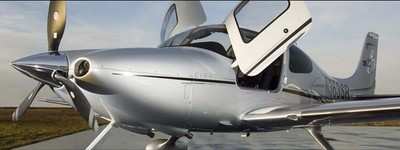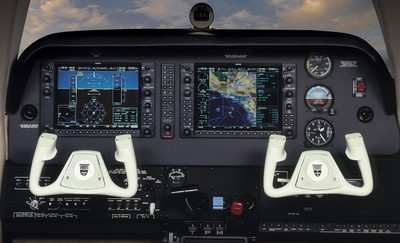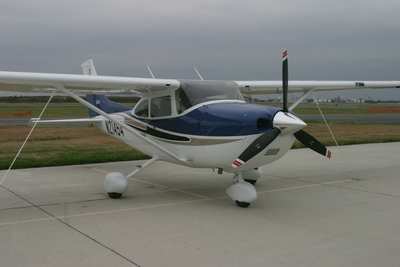Is It The Right Option For You?
By ANN Contributor Thomas P. Turner
 Fractional ownership.
This aircraft ownership option has seemingly sprouted almost from
nowhere in the last few years. Although fractional ownership of
professionally flown turbine aircraft appeared a few years earlier,
the rise of owner-flown fractional ownerships began concurrently
with the introduction of what we now call Technically Advanced
Aircraft (TAA)--airplanes with moving-map GPS and autopilot
technology, more and more frequently with "glass cockpit" Primary
Flight Display (PFD)/Multifunction Display (MFD) panels.
Fractional ownership.
This aircraft ownership option has seemingly sprouted almost from
nowhere in the last few years. Although fractional ownership of
professionally flown turbine aircraft appeared a few years earlier,
the rise of owner-flown fractional ownerships began concurrently
with the introduction of what we now call Technically Advanced
Aircraft (TAA)--airplanes with moving-map GPS and autopilot
technology, more and more frequently with "glass cockpit" Primary
Flight Display (PFD)/Multifunction Display (MFD) panels.
Does fractional ownership make sense to pilots who fly
piston-powered airplanes? What are the deciding points on buying
into a fractional? What are the unique benefits of fractionals that
offset some of the costs? When are you ahead of the game to bypass
fractionals and buy an airplane outright? What might you consider
to decide whether fractional ownership makes sense for you?
To answer these questions ANN has spent several months
researching fractional ownership of owner-flown, piston-powered
airplanes. We've surveyed readers like you who are fractional
owners, who are currently considering buying into a fractional
program, or have been fractional owners but have left the program
for one reason or another. We've also polled managers of
fractionals. With this cross-section, we got a sense of each
perspective toward fractional ownership of owner-flown piston
airplanes-you'll see quotes from several ANN readers' responses as
you read this report.
A new perspective
The service provided by fractional programs seems well-suited to
a new type of airplane owner -- one with little time or inclination
to be personally involved in the upkeep of the aircraft. An
airplane, to these pilots, exists to save time... not take extra
time out of their busy lives with scheduling inspections or
changing the oil or even pulling the airplane out of the hangar and
cleaning the windshield before a flight.
"I show up at the airport, preflight the plane and go. After
the flight, I turn over the keys and they handle the rest." --
Current fractional owner

Cirrus, in particular, has been very successful in marketing to
low- to no-time pilots who want or need high-speed, on-demand
personal air transportation and who want to do the flying
themselves. Perhaps not coincidentally, fractional programs to date
have been populated largely with Cirrus aircraft. This introduces a
new perspective for airplane owners who have little or no
expectations of what "traditional" pilots accept as part of
airplane ownership, all the extra things that demand time and
effort on the ground. Customer service-intensive fractional
ownership programs are positioning themselves perfectly for the
very busy professional who wants to fly but who does not have the
time for the rest of ownership's duties.
As quoted on ANN, Erik
Lindbergh, founder of Columbia 350-flying iFly calls fractional ownership
"a wonderful 'hands off' experience-hands off registration,
maintenance, tie-downs, repairs etc." Lindbergh (below) calls
it "the ultimate turn-key experience" for aircraft ownership --
"you reserve the plane, you turn the key, and fly!"

"The advantage of fractional ownership: No worries or
responsibility for the aircraft and I'm able to fly aircraft I
couldn't afford to own by myself." -- Current fractional
owner
If you like to tinker with or custom-outfit the airplane, leave
your things in the aircraft where they'll always be where you want
them, are the type to do owner-assisted annual inspections and oil
changes, or just like to putter around the hangar on a Sunday
afternoon, then fractional ownership probably isn't for you. But if
you like the convenience of having the airplane prepared for you
when you arrive and dropping it off "at the curb" when you return,
then being part of a fractional is better (and probably safer) for
you than any other type of ownership.
Just because the management puts your airplane right outside the
door, however, don't get tempted to jump in, fire up and take off
without complete trip planning and a thorough preflight
inspection-these tasks are always part of personal aviation.
Training requirements
One of the big advantages of most fractional ownership programs
is that they allow owners to fly Technologically Advanced Aircraft
(TAA) like the Cirrus, the Columbia or the Raytheon G36. With
flying TAA comes the need for proficient pilots. This leads to one
of the side-benefits of being part of a fractional ownership
plan-pilot training.

Getting your foot in the cockpit door of such capable airplanes
means you'll need some experience. AirShares
Elite is typical of most fractionals flying TAAs,
requiring for program pilots to "have the skill set of a 350-hour,
instrument rated pilot." Although AirShares says "there are no
absolute minimum hours required, you need to be a proficient,
current and meticulous pilot with the maturity and judgment skills
to handle a high-performance aircraft." To that end AirShares, like
other fractional managers, has a pilot transition and recurrent
training program that is an absolute requirement for all pilots in
the program. Training includes completing a thorough ground and
flight training syllabus and a mandatory program orientation.
Additionally, all program participants are required to complete
refresher training "at least annually" with an AirShares authorized
instructor. The expectation is that "even the most experienced
pilots" will "accomplish 10-15 hours of dual instruction annually."
As one fractional manager put it, "our owners are typically more
current and more safe than most other pilots."
"No hassle, great airplanes, a great training program" --
Current fractional owner
Insurance
Taking care of one of those pesky details of airplane ownership,
insurance, is part of the service provided by fractional managers.
Insurance cost is determined by the underwriters' evaluation of
what is called the "risk"-the combination of pilot, aircraft type
(and cost), and operating environment (commercial vs. personal
business use, airport at which the aircraft is based, etc.).
Fractional plans' entry-level requirements for pilots, and
mandatory initial and recurrent training, help prospective TAA
owners become "insurable" at experience levels where they may not
be able to get a policy on their own. Most importantly, the
fractional managers take care of the details of insurance-all the
individual pilot needs to do is to complete required training, be
legal under Federal Air Regulations (FARs) to operate as
pilot-in-command, fly the airplane as intended (no commercial
operations or unapproved instructional flying, for instance), and
of course pay his/her fees to be in good standing with the
fractional program, and insurance is taken care of at no additional
cost.

Liability insurance
Most fractional plans advertise $1 million "smooth" liability
coverage. This means that, in an incident covered by insurance, the
policy will pay $1 million to any claimant who successfully sues
the owner(s) for a loss experienced as a result of operation of the
airplane-for example, an injury, death, or identifiable (to the
court) financial losses like loss of future income, companionship,
or business. The liability coverage also pays in cases where such a
suit is settled out of court. "Smooth" coverage means that there is
no smaller cap on coverage for payments to persons who were
passengers in the aircraft at the time they experienced loss-a
common limitation on aircraft insurance, especially for owners new
to an aircraft type.
Two potential "gotchas" of the typical $1 million liability
policy in fractionals:
- In many cases pilots with the financial capability to
participate in fractional ownership are worth significantly more
than $1 million. There is nothing that limits the amount a person
may sue the pilot over a loss; the limitation is on what the
insurance company is obligated pay. If a judgment against the pilot
exceeds $1 million he or she is personally liable for the
additional amount. It's rare to find "umbrella" policies
(additional liability insurance to cover amounts over that paid by
"primary" insurance) that do not exclude general aviation, so a $1
million policy offered through the fractional program may not be
sufficient to protect a wealthy fractional owner.
- The $1 million liability limit is also a cap on the total
insurance will pay all parties sued as a result of operation of the
aircraft. Fractional owners, especially those with equity ownership
of specific airplanes, may be sued even if it's one of the other
pilots who caused the loss. This is especially true if an accident
can be traced to maintenance or a failure of the airplane (for
instance, an engine failure in flight). Four owners each owning
¼ equity in an airplane may all four be sued if one pilot
has a mishap-and given the $1 million liability cap on the policy,
each owner therefore has effectively only $250,000 liability
insurance to protect against the suit. Liability covers defense
costs in addition to this amount, but if the owners are found
liable individuals may be responsible for much more of the
settlement or award. Again, individuals in fractional programs may
want to investigate umbrella policies that provide additional
protection in the event of a loss.
Physical damage insurance
Most fractional plans include 100% coverage against physical
damage to the airplane itself. This is often called "hull"
coverage, evidence of the aviation industry's nautical roots.
Usually there is a deductible, or portion of the policy an owner
must pay before insurance kicks in; in this class of airplane the
deductible is typically between $1000 and $10,000. Under fractional
contracts owners are usually responsible for paying the deductible
if they cause damage to the airplane, although if the plane is
damaged through no owner's fault (for example, in a hangar fire)
the individual equity owners may have the deductible waived by the
program managers.

Aspects of liability and physical damage coverage may differ
among fractional plans, and exclusions and conditions may apply
even for different scenarios within a fractional program. It's best
to review in great detail the insurance aspects of fractional
ownership before committing to a program, and carefully read the
policy each year when it is renewed to look for any changes that
may affect how you'll be liable in the unfortunate event you or one
of your program partners experience or cause a loss.
Coming Thursday: Maintenance And Scheduling Pros...
And Cons
 ANN's Daily Aero-Term (04.20.24): Light Gun
ANN's Daily Aero-Term (04.20.24): Light Gun Aero-News: Quote of the Day (04.20.24)
Aero-News: Quote of the Day (04.20.24) ANN's Daily Aero-Linx (04.21.24)
ANN's Daily Aero-Linx (04.21.24) Aero-News: Quote of the Day (04.21.24)
Aero-News: Quote of the Day (04.21.24) ANN's Daily Aero-Term (04.21.24): Aircraft Conflict
ANN's Daily Aero-Term (04.21.24): Aircraft Conflict








